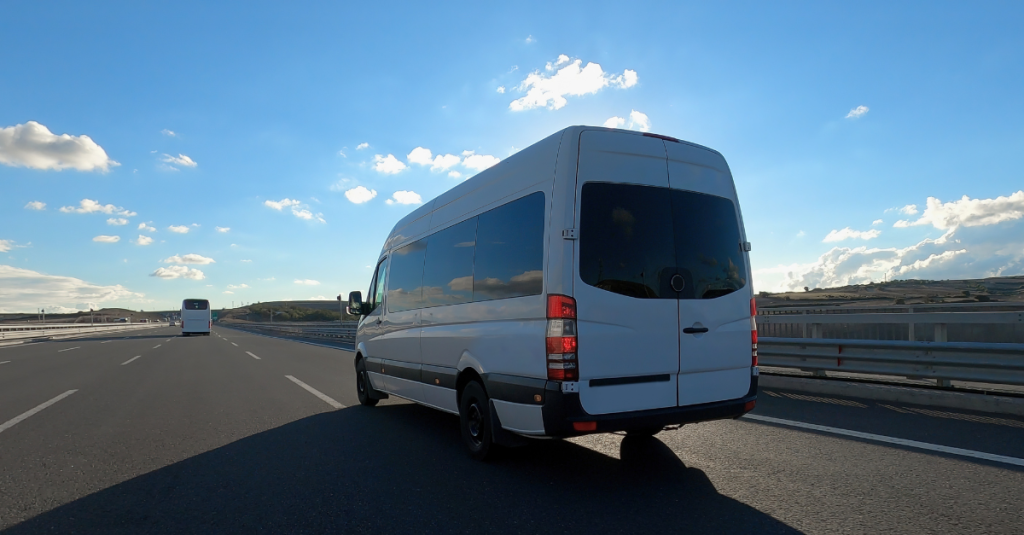
Driving a minibus for commercial purposes without the correct licence is illegal. In the UK, a standard Category B car driving licence may allow some people to drive minibuses under specific conditions, particularly for private or voluntary use, if they passed their driving test before January 1, 1997.1 However, for commercial operations—such as transporting passengers for hire, schools, tour companies, or employee shuttles— you’ll need a Category D1 licence (minibus licence). A D1 licence allows you to drive a minibus with the following features:
- No more than 16 seats
- Length of vehicle: maximum 8 metres
- You are eligible to also tow a trailer of a maximum weight of 750kg 2
What else do you need?
For commercial purposes, you’ll need to pass additional tests to obtain a full D1 or D licence, depending on the vehicle’s size and usage. This involves a medical examination, passing a theory test, and completing a practical driving test for minibuses.
You’ll also need to undergo Driver Certificate of Professional Competence (CPC) training if you’re driving the minibus for hire or reward. A CPC demonstrates that the driver is qualified to meet these responsibilities. The CPC training, which is required for anyone driving a minibus for hire or reward, is focused on the importance of professional driving standards, customer service, and compliance with working time regulations.
If you’re driving a minibus on a commercial basis, you will also need:
- Minibus Provisional Entitlement, also referred to as a Passenger Carrying Vehicle (PCV) licence.
- Public Service Vehicle (PSV), if you are carrying paying passengers on a Hire & Reward basis.
What if your vehicle doesn’t fit into either category?
If the vehicle has less than nine seats, you won’t need a D1 licence. A D licence lets you drive any type of bus with more than eight passenger seats, and with a trailer up to 750kg maximum authorised mass (MAM).3
How does a licence affect your insurance?
Driving with the wrong minibus licence can significantly impact your insurance coverage in several ways:
Invalid Coverage
If you’re driving a minibus without the appropriate licence, your insurance may be invalid. Most insurance policies require drivers to hold a valid licence for the vehicle they’re driving. If you don’t have the correct licence, your insurer might refuse to cover any claims, leaving you responsible for all damages and costs.
Claim Denial
In the event of an accident, if it’s discovered that you were driving with the wrong licence, the insurance company may deny any claims you make. This could apply to both damage to the minibus and any third-party liability.
Personal Liability
Without valid insurance, you could be personally liable for any damages or injuries caused in an accident. This could lead to significant financial consequences, especially if the accident results in serious injuries or property damage.
Legal Consequences
Driving a minibus without the correct licence can also result in legal penalties, such as fines or even a driving ban. This could further complicate any insurance issues, as insurers may increase your premiums or refuse to insure you in the future. If you run a commercial or community transport business, employing drivers without the correct qualifications can lead to further penalties, such as loss of insurance coverage, fines for non-compliance with safety regulations, and damage to your company’s reputation.
Higher Premiums
If your insurer finds out that you’ve been driving with the wrong licence, they may increase your premiums when you renew your policy, as you’re considered a higher risk.
To avoid these issues, it’s crucial to make sure that you have the correct licence for the vehicle you intend to drive and to inform your insurance company of your driving qualifications.
Road Safety
Minibuses are larger and more challenging to handle than regular cars, especially when they are fully loaded with passengers. The additional training and testing required for a D1 licence ensures that drivers are proficient in handling these vehicles. This includes mastering vehicle control, manoeuvring in tight spaces, and understanding the additional stopping distances required for heavier vehicles.
Drivers must also be knowledgeable about minibus-specific safety features, such as emergency exits, passenger seat belts, and the correct procedure for loading and unloading passengers, particularly children or people with mobility issues. The enhanced awareness that comes with proper training can reduce the risk of accidents, ensuring the safety of both passengers and other road users.
Passenger Welfare and Responsibility
Minibus drivers often transport vulnerable groups, such as school children, elderly individuals, or tourists unfamiliar with the area. A trained and licensed driver is more likely to provide a safe, comfortable journey and be prepared to handle emergencies or unexpected situations.
Make sure your licence and your insurance policy are current and up to date. If you’re not sure whether you have the correct licence for driving a minibus, our experts can advise you. If you would like to talk to us about your minibus insurance, get in touch. Our team of experts will search for a policy that is affordable and effective, so that you can drive safely and with confidence.
Call us now: 0344 776 5304
